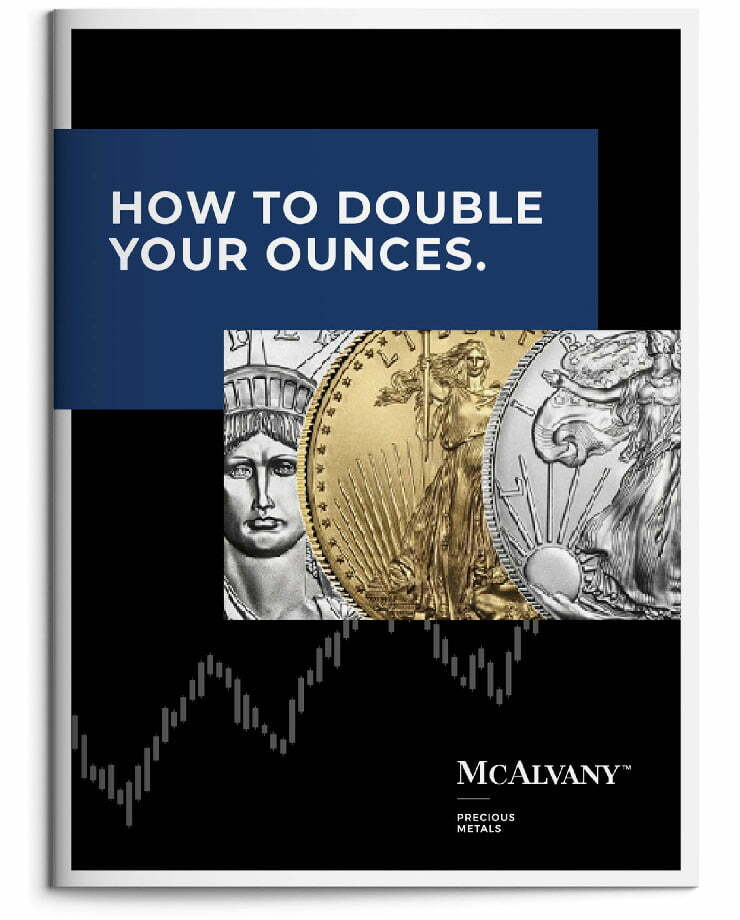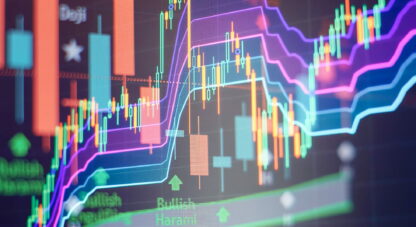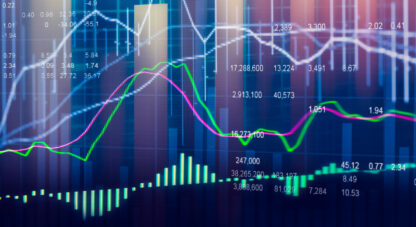Podcast: Play in new window
- Buffett Eyes Japan As A Stronger Currency
- Trump Is Isolating Iran From Its Perceived Friends
- Register For Thursday’s Webinar
“What we will look for as the final element in the international investor trifecta spurring on increased capital flight is when the US economy slows considerably. So if you then combine a slowing economy on top of a dollar in decline and throw in a rising rate environment, regardless of what the Fed is doing at the fed funds rate, you will see money rush out the door.” —David McAlvany
* * *
Kevin: Welcome to the McAlvany Weekly Commentary. I’m Kevin Orrick, along with David McAlvany.
David, for years we’ve done bank ratings for people, and one of the aspects that we look at with banks is something called hot money. Hot money is money that goes in for a reason, maybe it’s a return, and it can come right back out. And so you always have to be careful with hot money because it’s not loyal. It’s money that could just as easily disappear as it appeared.
David: Typically, it’s there for some benefit, maybe a yield differential or maybe a Sunbeam toaster. You got it as you walked in the front door, and you walked out with the toaster and your money. It was that fast of a turnaround.
Kevin: So here’s a question because we’re seeing downgrades here in the United States. Is there hot money that has come into the United States that could just as easily leave?
David: I think that’s what we get to test as the year goes by. We had the Moody’s downgrade last week. They complete the trifecta of downgrades, and no, it’s not of great consequence. Fitch and S&P concluded that our government was dysfunctional and we had a debt and deficit problem a long time ago. So why it took Moody’s so long is more surprising than the downgrade. If any of the three agencies were to take their gradings down two to four notches, now that would be of consequence. Bond yields merely reached to the Wednesday highs, as if to acknowledge the shift, but more as a shrug of indifference than really any acute concern. They actually closed lower on the day of the announcement by 3.2 basis points. And just as a reminder, S&P Global lowered their ratings in 2011.
Kevin: So 14 years ago. It sounds like Moody’s is a little clueless, like Comey is about messages on the beach. It’s like they’re a little late to the party.
David: I don’t know what the numbers mean.
Kevin: Yeah, that’s right. But okay, so let me ask you though, other countries, the United States is seen as the reserve currency. Good as gold, isn’t that the whole idea? The Treasury is supposed to be as good as gold. Do other countries have higher ratings than the United States at this point?
Yeah, well, in terms of consequence, there was none. But appearances may over time diminish the sheen of US assets, whether that’s Treasuries or stocks or what have you. There are now 10 other countries with higher ratings than the US. The setup in 2011, going back to the S&P downgrade, I think the setup was quite a bit different. The 2011 downgrade coincided with an incredibly weak dollar. It was trading in the seventies, which was actually en route to much higher levels. We were putting in the lows and we’ve had since then a tremendous move higher. Maybe this time ends up being different. Certainly the backdrop is distinct. If Moody’s downgrade coincides with a secular trend of US weakness and lack of foreign support for Treasury purchases, the result will be very different indeed.
So the current administration and the desire for reserve managers to diversify out of Treasuries and into gold, that’s a hallmark of 2025, and it’s somewhat at odds with what the current administration would like to see in terms of lower rates and a lower dollar, because frankly they’re just adding fuel to the fire. They’re motivating, if you will, those reserve managers to make haste to the exits. Again, this was hardly the case in 2011. As European debt markets circled the drain in 2011, the US Treasury market looked pretty good. That was then.
Kevin: Yeah, and so that was a downgrade in 2011. But let’s go back and look at what Mario Draghi was doing in 2011. He said, “We will do whatever it takes,” and that probably was one of the reasons why the dollar strengthened, wasn’t it?
David: He pledged everything fiscally, everything monetarily. He pledged everything to fix what was going on in Europe, and that blanket promise certainly caused a revival in what were pressured assets. The US was already in recovery, and we basically were ending a 12-year streak of US equities being flat to down. People forget that gold had a good run from 2001 and ’02 up to 2011 and ’12, and equities were negative that entire decade. So the current US administration, they have designs for a weaker currency.
Kevin: Right. They’ve been vocal about it.
David: And we haven’t given up any ground in the short term this week. Again, with the downgrade, what was the effect? Really, none at all. But by year-end markets are likely to conspire against the Treasury Department’s dream of lower rates, of a lower dollar. Perhaps a lower dollar, and we could certainly see more people hit the exits, but rates are a different matter. We will be talking a lot about regime change on Thursday morning this week. Join us as we explore hard assets in gold. Two of my colleagues will join me in presenting on what we view as a grand global economic reordering. If you want to register for the call, join us Thursday for insights on gold and other hard assets. The title of our presentation: The Grand Economic Reset, What It Means for Gold and Commodities, May 22nd, 10:00 AM Mountain, noon Eastern. You can follow the link in the show notes.
Kevin: And I would highly recommend tuning into that because Morgan is bringing a narrative right now, Dave, that I’m not seeing elsewhere. We are seeing a recycling out of dollars and into gold, and Morgan really seems to have nailed that narrative. So I look forward to that show. But let’s talk about rates for a while because we talked about Mario Draghi. One of the ways that you can control a market when it’s not completely out of control is by raising and lowering rates. But what we’ve seen here recently is the Federal Reserve can lower short-term interest rates and yet the long-term rates continue to rise.
David: Well, and this is certainly a judgment of the market, and a difference of opinion. The shift higher in rates since September has been one thing. So you’ve got the Fed lowering the fed funds rate, but here is your market signal, with the market moving the opposite direction, over 120 basis points higher. That is your market signal.
This week the only other bond market reference points that were notable, the MOVE Index is up—to quote our president—bigly, and mortgage rates are edging back towards 7%, closing Friday at 6.81. Not great for the housing market, and I think you’ve got alarm bells to ring if we get the 10-year Treasury over 5%, and of course over 7% you’re talking about for whom the bell tolls in terms of the real estate market. And frankly, equity markets might take notice too.
Kevin: So the big wave that we’ve been talking about, and I’m wondering if this is what pushed Moody’s—pushed their needle—is the interest on our debt now that it’s around $37 trillion. Interest on our debt must come down. We can’t afford it.
David: Yeah, well, the critique from Moody’s was heavily tied to the extension of the 2017 Tax Cuts and Jobs Act, the concerns of $4 trillion in addition to the primary deficit over the next decade. What gets me is that interest expense, it got a mention, but it was very much a secondary consideration.
Leave the tax cuts off the table for a minute. If interest expense flat lines at current levels, it’s a $12.5 trillion add to the fiscal deficit over a comparable ten-year period,—at a minimum. So I wonder, is the concern over $4 trillion—again, this is going back to the Tax Cuts and Jobs Act from 2017—is there concern over that just because that’s voluntary and avoidable versus the $12.5 trillion in interest that is an obligation already and unavoidable?
Kevin: And in a way it sounds a little political that they’re focusing on the tax cuts under Trump versus the interests that everybody has built.
David: Well, I’m just trying to understand where Moody’s is coming from. And of course, there is some bias in counting the tax cuts as only a cost while not exploring the GDP growth, which can also be associated with a private sector recycling of capital back through the economy via the tax cuts. So when you look at debt to GDP or deficits to GDP, GDP is the other component. If you’re driving GDP growth, then the increase in debt is less consequential.
New cuts are also on the table, cuts like tax on tips—be a growth generator as well to a small degree. You’ve got a major overhaul of drug costs, which would be a bonus to middle America. I think it’s very crowd pleasing and certainly an enhancement to those living on a fixed income, to their spending. The interest piece, that’s the real albatross. Market dynamics have driven up yields. At the same time, the Treasury is, this year, 2025, rolling over $9 trillion in debt.
Kevin: Having to pay higher interest each time.
David: And needing to finance upwards of another $2.5 trillion in new debt. So that’s $11.5 trillion in 2025 at higher rates of interest. And that means that the interest expectation of $1.25 trillion a year may be quite conservative. At the same time, you’ve got the Chinese and Japanese buyer’s strike happening. The most disruptive move in the financial markets for 2025 could well be rates bumping even higher. We just can’t find enough buyers of Treasuries, so prices go down, yields go up. Expectations are for one to two cuts in the fed funds rate by December. I think that’s the 16th, and I don’t think we’ll see anything happen until September.
The Fed is hesitant to do anything without a notable deterioration in economic statistics. That actually we could have in that time frame, August-September, hypothetically. Imagine the economy coming under pressure by late summer. Certainly the argument has been that tariffs have yet to factor into the economic statistics, but we may see them take a bite and have an impact by that time.
Okay, so that’s pressure in the economy late September—hypothetically—rates finally being reduced, only for more of a divergence to materialize between the Fed’s target and the market-determined rates farther out on the yield curve. Because again, we’re dealing with rollover risk which is very real, $9 trillion, plus the $2.5 trillion that has to be financed. That sets you up for an epic market correction in equities.
Kevin: We’ve been talking about how important it is right now to take an objective approach to making these predictions. I asked you if the Moody’s thing might’ve been political because they’re basically saying, “Well, the danger is those 2017 tax cuts,” but they’re ignoring, to a degree, the high interest.
I’m wondering, Dave, we talked last night about the difference between signal versus noise. Noise is when you have things happening that are not consistent with each other, so you don’t really get a signal. And what we’re seeing politically right now, those who like Trump are really very encouraged. Those who don’t like Trump, it’s the end of the world for them. It’s an amazing thing. And so I’m thinking about this University of Michigan Consumer Sentiment. It’s been dropping, but isn’t that mainly a Democrat—isn’t that mainly a liberal leaning index?
David: Well, I would say this. Anytime you look at the University of Michigan Consumer Sentiment Index, it is going to skew positive or negative according to who’s in office at the time. So the University of Michigan Consumer Sentiment at 50.8 versus a year ago, numbers of 69.1. Big change in a year’s time. With the expectations component now at lows not seen since May of 1980. And again, it does skew blue in this sense. So amongst Democrats, especially negative, slightly better amongst independents, and downright sanguine amongst the GOPers polled. So again, you’re talking about inconsistency. Couple that with a stock market ripping higher in rally mode, suggestive of “all is well,” hardly a uniform match.
You could read it as a striking inconsistency where public investment consensus is bullish and bright while a particular sampling of Democrats shows the darkest readings in 45 years. Again, this is the University of Michigan index. So over 50% of the time consumer expectations are as low as they are reflected in this particular measure, you are in a recession. That we are not in a recession yet is also notable, at least for now.
Kevin: Did you see the different opinions on inflation going forward and just how politically skewed that was?
David: Yeah, bias is everywhere, and rarely is it fully accounted for. So I think it does help to know that the University of Michigan numbers had lower expectations in terms of sentiment amongst Republicans and still higher expectations for inflation, but they were flipped to the dark and even depressive side with Democrats polling really in a panic, inflation expectations north of 10%. That’s amongst Democrats, versus Republicans under two.
Kevin: Huge, huge diversity.
David: That’s quite a difference in perspective. So if you take the blended one-year inflation expectations, 7.3%, and that is well over the 3.3 from a year ago. But again, the blue skew was notable. To be fair, the University of Michigan reflects policy preference and political party all the time. If you go back to the 1980s, survey data was maybe 20 points difference. Again, if you’re looking at Democrats versus Republicans, and that was in the ’80s and ’90s, with the party in office being positive and the party out of power being negative, and I mean it really is that simple. Who’s got the power? That party is super positive on the direction of things, and the losing party is super negative. Get into the 2000s and there’s about a 30-point difference.
Kevin: Wow.
David: Now it’s typically 30 points, with some measurements being in the 40s, and the May consumer sentiment measures were in this case separated by over 50 points. We had Democrats at 33.9 and Republicans at 84.2, probably one of the biggest differences ever. So all that to say, politics drives perceptions like it was the best of times or the worst of times depending on how you vote.
Kevin: It just hardly seems like a useful tool when there’s that much disparity between the political sides. But my wife and I were talking about marriage and how, when you first get married when the other person does something, if you react right away, it’s not going to go well most of the time. But the older I get, the more I learn to wait and try not to react right off the bat because maybe there’s things I haven’t taken into consideration, and I’m watching Trump, Dave, and he can get those who hate him to react right away. And it’s amazing how they chase every rabbit that he throws out there. But if we just wait— Let’s look at the tariffs for a second. Okay, the tariffs sounded incredibly radical. Now we’re on a tariff pause. I mean, is it going to be much more sedate, let’s say, than what we thought in the beginning?
David: Yeah, I think we certainly had the market instability preceding the 90-day tariff pause. And I think the question there really is, “Will we see a shift in the tariff strategy going forward?” And time will tell. I think there is a use in ambiguity. There is a skill in creating uncertainty in terms of how he negotiates. So far, as a negotiating tactic, the creation of uncertainty has been very effective. This has been, if you look back at the last two weeks, an incredibly busy two weeks.
Kevin: Oh yeah, look at the Middle East. They’re moving the needle someway.
David: The flurry of deals in the Middle East was a success. Saudi defense and technology spending was off the charts, $600 billion, very impressive. Longer-term insinuation of up to a trillion dollars in spending from Mohammed bin Salman. And we had, from other Middle East countries, huge Boeing orders. Frankly, if you just look back at the week Trump traveled through the Middle East, one of the key things to consider is how he effectively consolidated interests against Iran and really towards a greater peace in the Middle East. Even the move with Syria was very effective in muting Iranian influence. This was an Iranian power proxy for how many decades now. So again, just solidifying the move toward reducing sanctions and making life a little easier on Syria. I think it begins to shift power dynamics in the Middle East. It was really an interesting couple of weeks.
Kevin: “The enemy of my enemy is my friend,” seems to be what Trump does to isolate those who are going to try to stay enemies.
David: Iran is more isolated at the end of last week. Of course, Iranian sanctions are back on the table, and it doesn’t appear that they’re going to be a really big thing. A fascinating article from Gillian Tett—she’s a great writer for the Financial Times—very insightful bit of commentary specifically on Iranian sanctions, and just reminding readers that the existing shadow fleet of tankers carrying Russian crude has grown so substantially in the last three years as a result of these sanctions. There’s really no way to cut off Iranian oil from reaching its Chinese destination. So the work Trump did to isolate Iran last week was even more important than any possible sanctions.
Kevin: I want to move to the markets for a moment because leverage is everything. When things are really flowing, leverage is a huge, huge deal, and you get the hedge funds in there and not only are they using leverage, but they’re using just a lot of derivative types of investments to where the market itself is operating much larger than the actual underlying investments. And I’m just wondering where are the hedge funds right now? Are they still using the leverage that they were last year?
David: It is fascinating because it feels like their sentiment matches the University of Michigan numbers pretty consistently, where they are out of the market and there’s a negative tone. They are not completely out, of course, but they’ve reduced their leverage pretty considerably. And so with leveraged speculators and hedge funds less engaged, I think you can also assume that market participants are also at this point less hedged. That sets up a unique market dynamic where if a selloff ensues, you have to go buy your insurance, you have to get your hedging, if you will, at some elevated cost versus already having downside protection in place. And it’s the leveraged speculators that typically have some of that hedging already in place. So if the cost to hedge is too high, it’s easier to just liquidate.
Kevin: Okay, so the man on the street, what you’re basically saying is it costs more because you don’t have the big boys actually leveraging for you?
David: Well, I would say that the man in the street just doesn’t do as much hedging, and so they’re faced with a different set of alternatives, and the leverage crowd scaling back market exposure, the man in the street stepping up purchases. I think we can assume the sort of Main Street view of risk embracement and positive prospects for growth. They’re not assuming the same dire outcomes as expected by your DC power brokers, by the media, or by what you might consider the leveraged elite.
Kevin: So on Thursday you guys are going to be talking about recycling out of the dollar. A lot of that recycling has been into gold, but the recent news is that Japan is starting to look good for some of that recycling as well. Even Buffett, Warren Buffett— Everybody watches what he does. He’s liking Japan right now.
David: We’ve said for a long time, watch bonds, watch currencies. These are where your signals are going to come from, where they continue to be coming from. Flows out of dollar assets are a trend to watch. And of course, that’s going to show up in your currencies too. Japan and Europe both have been destinations. European stocks have vastly outperformed US equities year to date. You’ve got Germany, if you look at the DAX, up 19%, Spain up 21%, Italy up 19%. Inflows to Japan I think could pick up further as the year progresses. Buffett’s disclosure of Berkshire Hathaway significantly increasing Japanese purchases, I think that’s supportive of a trend in the direction of Japanese assets.
For the month of April, inflows into Japan totaled $56.6 billion. That was a combination of equities and bonds. And some analysts are quick to point out that this may be just less money flowing to the US and not an outright liquidation, a pulling of funds from the US. So again, just more Japanese savers and international folks looking at the Japanese markets with intrigue.
We’ve noted in recent weeks a weak dollar certainly raises the possibility of capital flight from US assets, which could be as vicious a cycle as the previous decade has been virtuous. And so a hit to asset values and stocks and bonds at the same time currency pressure is increasing, that’s a real possibility. And it would just be a repeat of what we saw in the first quarter of this year where both of those things were in play.
The actual flight from US assets back into Taiwanese assets was a pressure point in April. It was a dramatic example of what it looks like in a very concentrated form and place. So if yields in the US move higher at the same time the US dollar is moving lower, I think that’s when a trickle exiting is likely to become a flood. And we see capital flows in 2025 defining asset values. Again, we look at these two factors of bonds and currencies, yields and foreign currency exchange, FX losses, those, in our views, are likely to increase those outflows.
Kevin: Well, and we started the show talking about hot money going into banks, and could we have hot money in this country? Over the last five years, what is it, $10 trillion of foreign investments came into the United States, but we had a strong dollar, we had strong equity markets. Is this outflow that you’re talking about, is that hot money leaving?
David: Well, yeah. I think to your point earlier about what hot money looks like, there was a reason—or many reasons—for the US to be an attractive destination. The last five years with a combination of a strong dollar, improving market prices, foreign portfolio holdings of US securities—both equity and debt—an increase by $10.3 trillion. It’s just a massive flow in, a lot of capital in, and it explains a significant part of US asset overvaluation, both in absolute terms and in relative terms compared to other markets. John Butler from Wellington Management, quoted in the Financial Times, notes that of all global savings held abroad, investors from around the world have 50% of their savings in US assets.
Kevin: So if there’s a reason to stay, that’s a lot of money here. If there’s a reason to go, that’s a lot of money that could leave all at once.
David: Right. So the trifecta of downgrades from agencies—we’ve got Fitch, we’ve got S&P, we’ve got Moody’s—what we will look for as the final element in the international investor trifecta spurring on increased capital flight is when the US economy slows considerably.
So if you then combine a slowing economy on top of a dollar in decline and throw in a rising rate environment, regardless of what the Fed is doing at the fed funds rate, you will see money rush out the door. And again, there are trillions in assets, $10.3 trillion just from the last five years waiting for a reason to stay, or in this case, three reasons to go—the economy, FX, and rates.
Second half of 2025 could be very interesting indeed. Give them one reason to stay, positive economic numbers, a strong dollar, lower rates spurring financial asset appreciation, and I don’t think you’ll see those flows hit the exits.
Kevin: If you’re a listener to this commentary, you obviously want to look forward and try to have the clearest approach possible. Dave, I can’t encourage our listeners enough to tune in Thursday for, what are you calling it, the Grand Economic Reset?
David: Yeah. Where do we see the markets going? Join us this Thursday, The Grand Economic Reset, What It Means for Gold and Commodities, Thursday, noon Eastern, 10:00 AM Mountain.
* * *
You’ve been listening to the McAlvany Weekly Commentary. I’m Kevin Orrick, along with David McAlvany. You can find us at mcalvany.com and you can call us at (800) 525-9556.
This has been the McAlvany Weekly Commentary. The views expressed should not be considered to be a solicitation or a recommendation for your investment portfolio. You should consult a professional financial advisor to assess your suitability for risk and investment. Join us again next week for a new edition of the McAlvany Weekly Commentary.
















